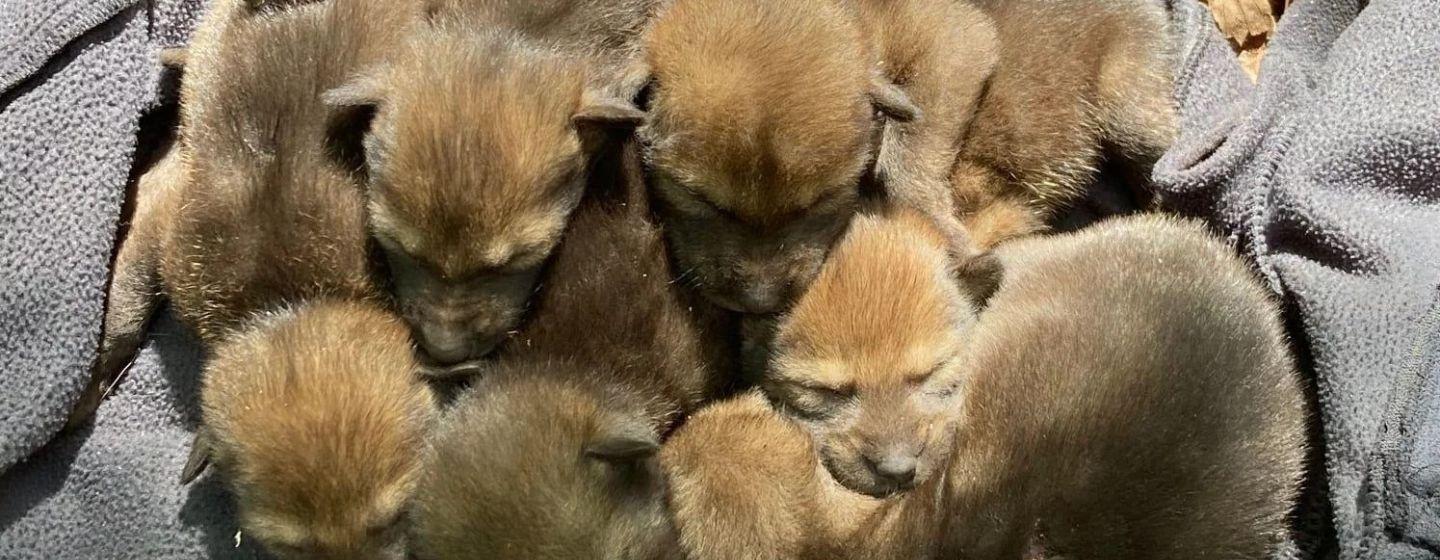Good News for North Carolina’s Critically Endangered Red Wolves


The U.S. Fish and Wildlife Service’s Red Wolf Recovery Program reports that a new litter of wolf pups has been born to what is known as the Milltail family pack on the Alligator River National Wildlife Refuge in eastern North Carolina.
It’s the second year in a row that wild red wolf breeding pair “2225F” (female) and “2323M” (male) have added to the pack. Born April 2023, this newest litter consists of three females and two males. And a few weeks later, biologists with the Wildlife Service gave the new family a surprise brother.
“Because of this red wolf pair’s proven ability to care for and nurture a lively bunch of pups, the Red Wolf Recovery Program fostered a male pup born at Point Defiance Zoo and Aquarium in Tacoma, Washington, into this wild litter, bringing this brood to six pups,” announced in a statement by the Wildlife Service.
Red wolves are one of the most endangered animals on the planet, which is why new births are such good news.
Not long after the Milltail pups were born in the wild, two broods of endangered red wolves were born at the North Carolina Zoo in Asheboro.
“We are thrilled to announce that we have had not one but two litters of critically endangered red wolf pups,” noted a release from the zoo. “The first litter, born to parents Marsh and Roan, has three pups, and the second litter, born to Denali and May, has six, for a total of nine pups!”
Red wolves have strong family bonds. Biologists with the Red Wolf Recovery Program expect the five siblings from the Milltail pack’s 2022 litter will help their parents with the new pups.
The new additions bring the total number of red wolves at the refuge to 13. 2022 saw the first red wolves born in the wild since 2018.
“This is extraordinary news for red wolves, because the family group is now a large, fully functioning pack with these news pups and the yearlings,” said Ben Prater, director of Defenders of Wildlife’s Southeast Program. “We are so grateful for the U.S. Fish and Wildlife Service’s biologists who made this happen. We’re hopeful this is a sign of things to come in the species recovery.”
Native to North America, red wolves are named for their characteristic reddish fur. They measure roughly between gray wolves and coyotes in size and weigh between 44 and 85 pounds, depending on sex.
Red wolves were once common throughout the eastern United States. But they faced extinction in the late 1970s after intensive predator-control programs and a loss of habitat decimated their numbers. That led to the wolves to be classified as “critically endangered” on the International Union for Conservation of Nature’s Red List.
Red wolves were one of the first species listed under the Endangered Species Act in 1973.
“People have killed them for generations,” said Will Harlan, Southeast director for the Center for Biological Diversity in an interview with Newsweek. The magazine recently shared on its website rare footage of a wild red wolf captured on a trail camera in the Alligator River National Wildlife Refuge.
“They were targeted in extermination campaigns throughout the 20th century. By 1980, red wolves were declared extinct in the wild,” added Harlan.
That prompted biologists from the U.S. Fish and Wildlife Service to capture the very last wild red wolf for an unprecedented effort at captive breeding. In 1987, biologists reintroduced four wild wolf pairs into the refuge. By 2010, the wild population had grown to 150 wolves.
The program became a model for reintroduction efforts of other endangered species. However, Harlan says political pressure and agency inaction caused the program to fall apart.
“Fortunately, the program—and the wolves—are starting to bounce back, but … gunshot remains a leading cause of death for red wolves,” Harlan explained.
In addition to the Milltail family pack, two litters of four red wolf puppies each reside in acclimation pens with their parents at the Alligator River National Wildlife Refuge. They will be released in early summer. With these litters and additional releases of captive-bred wolves, the wild population could total 35–37 by this summer. That means the wild population could quadruple in just two years.
There are now an estimated 15–17 red wolves living in the wild. Another 241 exist in captivity.
The Recovery Program ended its release saying, “A cause for joy and celebration in 2023, much like we experienced in 2022. Every generation yields a newborn hope for recovery of the Red Wolf.”